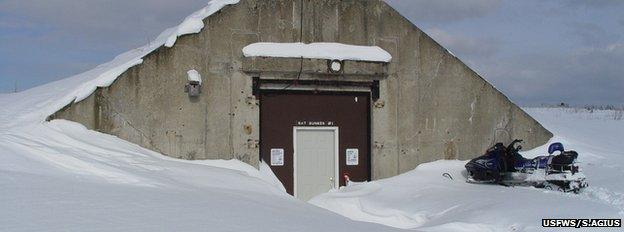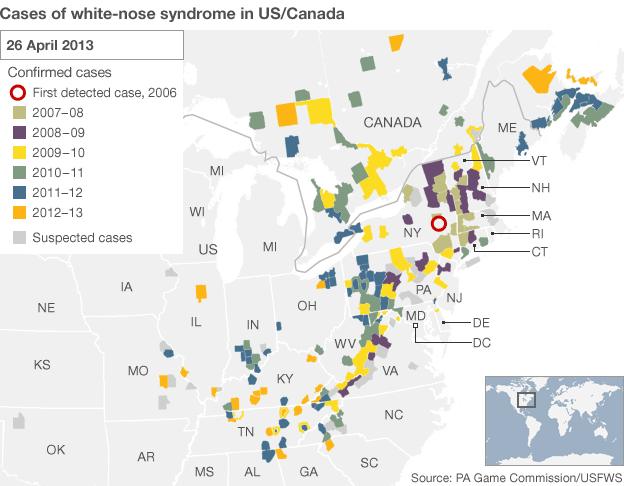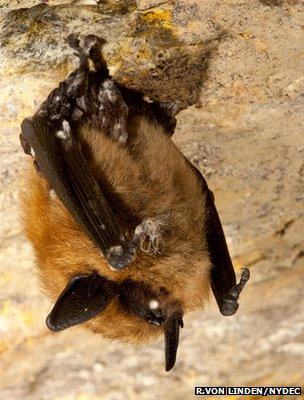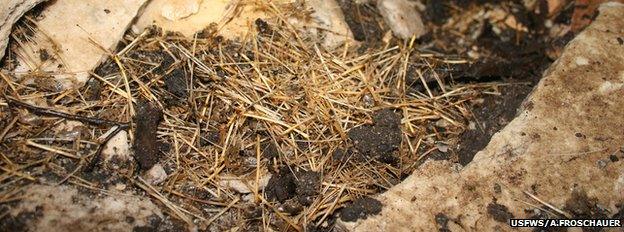Cold War bunkers offer bats refuge from killer disease
- Published

Cold War nuclear bunkers are being given a new lease of life, this time to protect bats against WNS
Cold War nuclear bunkers are the latest attempt to safeguard US bat populations under attack from white-nose syndrome.
Scientists have converted two of the 43 bunkers at the former Loring Air Force Base, Maine, which has been a wildlife reserve since the mid-1990s.
The artificial hibernacula are designed to safeguard bats from the disease that was first recorded in the US in 2006.
White-nose syndrome (WNS) has killed up to an estimated 6.7 million bats so far and is continuing to spread.
The disease, first described in a cave system in the state of New York, affects hibernating species is now found in 22 US states and five Canadian provinces.
The once secretive site in Maine, which was the closest US-based airbase to Moscow and a key asset for the US Strategic Air Command during the Cold War, was closed in 1994 before being reborn as the Aroostook National Wildlife Refuge, external.
Steve Agius, the refuge's assistant manager, said that staff felt the derelict grass-roofed bunkers had more potential ecologically than just offering nesting sites for sandpipers and sparrows.
"The bunkers remained a curiosity for years and biological staff speculated that perhaps the structures could provide overwintering hibernacula for bats," he said.
The devastating impact of WNS on a growing number of US bat species led to the bunkers being assessed as potential winter homes for hibernating bats.
As a result, one of the bunkers was modified by US Fish and Wildlife Service (USFWS) staff, and 30 male little-brown bats (Myotis lucifugus) arrived at their new winter home in December 2012.
The bunker's conversion included installing roosting places for the bats and CCTV to monitor the hibernating mammals.
Ann Froschauer, the USFWS WNS spokeswoman, explained the merits of using these artificial caves in the battle against the killer disease.
"One of the problems about WNS is that the fungus persists in the environment for an unknown amount of time and does not require bats as a host," she explained.
"If there are no bats then the fungus goes back to doing its normal soil function, such as degrading organic matter. Then, if any new bats come into the area, they are exposed to it."

Highlighting a fundamental barrier in curbing the transmission of the disease, Ms Froschauer added: "We cannot go into a natural cave or mine that has a lot of diversity - a lot of naturally occurring fungi - and then spray some sort of chemical.
"But in a human-made structure, like a bunker, we can go into a site like that [after the bats have left] and we can actually scrub a place down."
However, she said that even if the vast resources - financial and technical - needed to build a network of refuges for bats were available, the process of hibernation still held secrets waiting to be unlocked by science.
"Hibernation is something we are getting a lot better handle on but we do not really understand all of the things that are going on," she told BBC News.
"It is tough to hibernate bats and make sure we have all the right conditions - there are a lot of challenges."
The challenges facing attempts to extend this possible solution across the country were highlighted when biologists found that only nine bats - less than a third of the artificial colony - survived the winter.
Steve Agius observed: "While some of the bats survived the capture, transportation, and hibernation, it is clear that increasing the overwinter survival rate is essential when considering the value of further developing artificial hibernacula."
Descent into darkness: Biologist Carl Herzog heads into an abandoned mine to assess the damage of the killer disease
WNS has been described by some biologists as the worst wildlife health crisis in the US in living memory.
It is named after a white fungal infection that appears on the muzzle and/or wings of infected animals.
Researchers say the fungus (Geomyces destructans) thrives in the dark, damp conditions - such as caves and mines, external.
Studies suggest the fungus arrived in the US after it was somehow transported (probably via humans) from Europe or possibly Asia.
No turning back
Ms Froschauer said frontline efforts were focused on biosecurity in the guise of decontamination and restricting access to places where the disease was known to be present.

Early indications suggest the spread of the disease is continuing unabated
She explained US Geological Survey scientists had been able to cultivate viable fungal spores from tiny samples of soil, raising fears of a nightmare scenario of WNS being transported by humans or freight to western US states.
"A tiny chuck of soil - smaller than a US Dime - could easily be stuck in the tread of your shoe could easily be moved, especially if you were to jump on an aeroplane and not even be aware of it," she observed.
In order to minimise the risk of the disease being transported to unaffected areas, the USFWS and other agencies have produce decontamination documents, external for cavers, researchers and other groups that could come into contact with the fungus.
Even though efforts are being made to stop the disease spreading rapidly, WNS is still extending its range. In its recent update, the US FWS said the disease had been confirmed in Quebec, Canada - the most northerly case to date.
This suggests that the pathogen has not yet reached its limits in terms of how far it can spread geographically, meaning that bat experts and conservationists in these areas have to be on alert for signs of the disease.
Ms Froschauer said experts were resigned to the notion that strategies would have to focus on how to manage the disease, rather than eradicate it from the landscape.
"I expect to see over the next few years the spread continuing in those areas that are just getting the disease," she observed.
"We appear to be observing some sort of timeline between when the disease arrives to when we start to see these population level effects.
"To date, it is not slowing down, it is not stopping its spread."

Experts often faced caves full of remains where the disease had wiped out colonies of bats
She said evidence seemed to suggest that there was about a two to three year period between the disease first arriving in an area and signs that it was having an impact at a population level.
"We are getting a lot better at detecting the presence of the fungus earlier, we are finding the fungus in advance of seeing the disease manifest itself.
"A couple of years ago, the only way we knew there were affected bats was because we saw bats with the visible fungus growing on them and observing the behavioural changes."
Ms Froschauer explained that the scientific consensus was that this disease was here to stay and it was not going to be possible to "unpick what had been done".
"We will never see bat populations in the eastern US and Canada at pre-WNS levels in our lifetimes, or for generations afterwards," she warned.
"Our best bet now is to work towards how we can contain the disease while we are working on the science side of things and the other things that could interrupt the cycle of the disease and allow us to work towards the conservation of bats."
- Published10 April 2012
- Published26 October 2011
- Published18 May 2011
- Published24 December 2010
- Published6 August 2010